Sarah Sundin's Blog, page 460
September 25, 2012
Today in World War II History
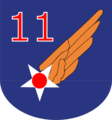 70 Years Ago—Sept. 25, 1942: Australians launch offensive for Ioribaiwa on Kokoda Trail, New Guinea. In first joint US-Canadian mission, 11th Air Force and Royal Canadian Air Force bomb Kiska and Little Kiska.
70 Years Ago—Sept. 25, 1942: Australians launch offensive for Ioribaiwa on Kokoda Trail, New Guinea. In first joint US-Canadian mission, 11th Air Force and Royal Canadian Air Force bomb Kiska and Little Kiska.
Published on September 25, 2012 03:00
September 24, 2012
Army Nursing in World War II - Training and Rank
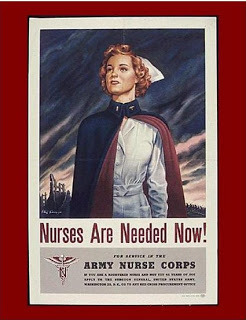 Since my new World War II novel,
With Every Letter
(Wings of the Nightingale book 1), features nurses, I'm conducting a blog series on Army Nursing during the war. Last week we looked at requirements to serve in the Army Nurse Corps. Today, we’ll discuss the training the nurses underwent and rank in the Army Nurse Corps. And in the following weeks, I’ll provide details on uniforms and general nursing practices.
Since my new World War II novel,
With Every Letter
(Wings of the Nightingale book 1), features nurses, I'm conducting a blog series on Army Nursing during the war. Last week we looked at requirements to serve in the Army Nurse Corps. Today, we’ll discuss the training the nurses underwent and rank in the Army Nurse Corps. And in the following weeks, I’ll provide details on uniforms and general nursing practices.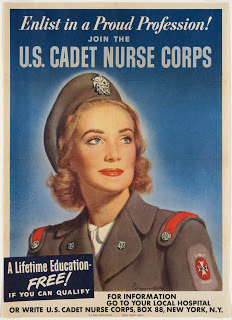 Recruitment and Training
Recruitment and Training
The American Red Cross served as the traditional reserve for the Army Nurse Corps. On October 9, 1940, the ANC called the reserves to active duty, to volunteer for a one-year commitment. At first there was no formal military training for nurses. On July 19, 1943, the first basic training center for nurses opened. Training centers were located at Fort Devens, MA; Halloran General Hospital, Staten Island, NY; Camp McCoy, WI; and Brooke General Hospital in San Antonio, TX. The nurses trained for four weeks, learning military courtesy and practices, sanitation, ward management, camouflage, the use of gas masks, and map reading. They also drilled and underwent physical training.
To train the increased number of nurses needed during the war, Congress authorized the Cadet Nurse Corps on July 1, 1943. The government paid for women to attend civilian nursing programs in exchange for service in the Army Nurse Corps upon graduation. The women in this accelerated program (two and a half years instead of three) had their own special cadet uniforms.
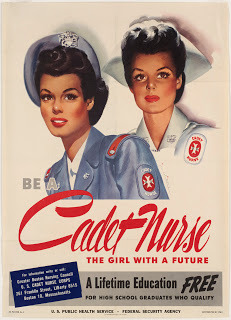 Rank
Rank
Nurses entered the ANC as second lieutenants, and the vast majority stayed at that rank. The chief nurse of a hospital was usually a first lieutenant, but sometimes a second lieutenant or a captain. The highest rank was held by the superintendent of the ANC, a colonel.
Even so, nurses held “relative rank.” They held the title, wore the insignia, were admitted to officers’ clubs, and had the privilege of the salute, but they had limited authority in the line of duty and initially received less pay than men of similar rank. On December 22, 1942, Congress authorized military nurses to receive pay equivalent to a man of the same rank without dependents, and on June 22, 1944, Congress authorized temporary commissions with full pay and privileges.
One of the nurses were granted officer status was to “protect” them from the great crowd of enlisted men, and—it was often believed—for male officers to keep the women for themselves. The Army had rules against fraternization between officers and enlisted personnel.
Flight Nurses
This week I'm also guest blogging on Redwood's Medical Edge about flight nurses in World War II. We'll also be giving away a copy of With Every Letter , so stop by and leave a comment!
Sources:
http://history.amedd.army.mil/ANCWebsite/anchome.html(The official website for Army Nurse Corps history.)Sarnecky, Mary T. A History of the U.S. Army Nurse Corps. Philadelphia: University of Pennsylvania Press, 1999. (A comprehensive history with a thick section on WWII).Tomblin, Barbara Brooks. G.I. Nightingales: the Army Nurse Corps in World War II. Lexington: University Press of Kentucky, 1996. (A wonderful history, including all theaters, full of personal stories).
Published on September 24, 2012 04:00
Today in World War II History
70 Years Ago—Sept. 24, 1942: Soviet pilot Olga Yamschchikova becomes first woman pilot to shoot down an enemy aircraft, over Stalingrad. Hitler dismisses Gen. Franz Halder, Chief of Army General Staff, for criticizing policy in east, replaced by Kurt Zeitzler.
Published on September 24, 2012 03:00
September 23, 2012
Today in World War II History
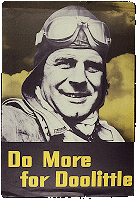 70 Years Ago—Sept. 23, 1942: Brig. Gen. James Doolittle named new commander of US 12th Air Force, which will go to North Africa. USS Lexington (CV-16) launched, Quincy, Massachusetts.
70 Years Ago—Sept. 23, 1942: Brig. Gen. James Doolittle named new commander of US 12th Air Force, which will go to North Africa. USS Lexington (CV-16) launched, Quincy, Massachusetts.
Published on September 23, 2012 03:00
September 22, 2012
Today in World War II History
 Master Sergeant70 Years Ago—Sept. 22, 1942: Germans split Soviet army in Stalingrad, occupy southern half of city. US Army raises grade of first sergeant to that of master sergeant.
Master Sergeant70 Years Ago—Sept. 22, 1942: Germans split Soviet army in Stalingrad, occupy southern half of city. US Army raises grade of first sergeant to that of master sergeant.
Published on September 22, 2012 03:00
September 21, 2012
Today in World War II History
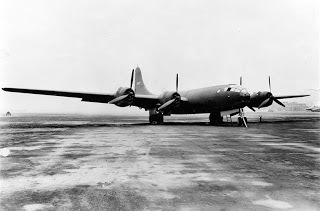 Boeing XB-29 Superfortress70 Years Ago—Sept. 21, 1942: British and Indian troops launch assault into the Arakan Peninsula in Burma. First test flight of Boeing XB-29 Superfortress in Seattle.
Boeing XB-29 Superfortress70 Years Ago—Sept. 21, 1942: British and Indian troops launch assault into the Arakan Peninsula in Burma. First test flight of Boeing XB-29 Superfortress in Seattle.
Published on September 21, 2012 03:00
September 20, 2012
A Chat with Nike Chillemi
 Today I thought it would be fun to introduce another author who loves the drama and adventure of the 1940s. Nike Chillemi writes crime fiction set after World War II, and she's answered some questions about her love for this time period.
Today I thought it would be fun to introduce another author who loves the drama and adventure of the 1940s. Nike Chillemi writes crime fiction set after World War II, and she's answered some questions about her love for this time period.First, a bit about Nike...
Nike Chillemi has been called a crime fictionista due to her passion for crime fiction. She is the founding board member of the Grace Awards and its Chairman, a reader's choice awards for excellence in Christian fiction. She writes book reviews for The Christian Pulse online magazine. Burning Hearts is the first book in The Sanctuary Point series, published by Desert Breeze. Goodbye Noel , the second book in the series released in December, 2011 and won the Grace Award 2011 in the Mystery/Romantic Suspense/Thriller category. Perilous Shadows, the third in the series released in July, 2012. She is a member of American Christian Fiction Writers (ACFW) and the Edgy Christian Fiction Lovers (Ning).
Nike, what drew you to write novels set in the 1940s?
I love the 1940s. The era had its own panache. There was a kind of natural glamour and sophistication to the period that didn't seem forced or egotistical. Ordinary women loved to dress up. The men were so debonair. I obtained my college degree from The Fashion Institute of Technology in NYC. I'm completely enthralled by the fashion, hair, and automobiles of the 1940s. It was also a pivotal time for our nation. So many American soldiers had fallen in the war. America seemed to be losing her innocence slowly but surely. Yet, in spite of great national and personal loss, Americans had great optimism then. There was a spirit of get up and go. I wanted to create characters who struggled with the issues that framed the America we live in today. What’s your favorite movie from the 1940s? Actor or actress from the 1940s?
Interestingly enough, in my newest release, Perilous Shadows, heroine Kiera Devane tells hero Argus Nye he reminds her of the actor who is my favorite from the golden age of cinema…Jimmy Stewart. That novel also has Kiera and Argus going to the movies. It's quite a humorous scene. The movie is Road To Riostarring Bob Hope and Bing Crosby and is a riotous film. Although Kiera and Argus go to the flick to have a respite from the murder case they're investigating, the scene pulls them deeper into the hunt for the killer. I also love Jimmy Stewart and the "Road" movies! What’s the most interesting thing you learned about this time period from researching your stories?When researching hero Lorne Kincade's backstory for the first novel in the series, Burning Hearts, I learned that French resistance fighters hid in the catacombs beneath Marseilles from the Vichy French and Nazis who had taken over France. Lorne appeared to be a simple motorcycle courier during the war, but in fact went on secret missions in France under the direct command of General Patton. I wrote a scene in that novel where now stateside, Lorne awakes sweating from a nightmare in which he and his wartime buddy race through the back alleys of Marseilles for the safety of the catacombs. In essence, Lorne has had a flashback in a dream.If you lived in the 1940s, what role would you see for yourself? Rosie the Riveter, ration-point-collecting homemaker, WAAC or WAVE, or daring spy?I think I would have been a WAAC or a WAVE, probably a WAVE because of my love of the ocean and the WAVEs were Navy. These women were considered part of the US Naval Reserves. Although WAVES only served stateside until the very end of the war when some shipped out to Hawaii, not yet a state. I would liked to have served in communications or intelligence. One necessary task in war time is poring through all the many newspapers published in the US looking for articles and/or advertisements that might be code from enemy collaborators or enemy agents. That is something I would have been interested in doing.That would be interesting! Nike's Books...
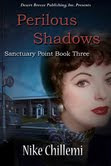 Perilous Shadows
"Nike Chillemi kicks off her new novel, Perilous Shadows, with gusto and keeps the action coming." ~ Nancy Mehl, Winner of the 2009 Carol Award for Mystery...author of Inescapable: The Kingdom series, the Curl Up and Dye mysteries, and The Harmony series.Pioneer newspaperwoman Kiera Devane is on a mission to prove a woman can do a man's job, as she hunts a young coed's killer? Ace radio broadcaster Argus Nye lost one love to a murderous fiend and his pulse races as he tries to protect Kiera from herself as much as from this killer. Kiera was doted upon by loving parent, but they were killed when she was a girl and she was shipped off to live with a socialite aunt who had little time for her. In her aunt's house, she learned life could be cold and cruel. As a result, she grew up to be an independent and demanding professional woman.Argus Nye, still bereft from the loss of his first love, can't understand why this female reporter is mesmerizing him. As she takes chances with her life trying to catch a killer, he's determined to protect her.Available at:Amazon/Kindle. http://is.gd/W2Hm2N Barnes and Noble/Nook. http://is.gd/RJF2zy Desert Breeze Publishing Author Page. http://tinyurl.com/7e92vwv
Perilous Shadows
"Nike Chillemi kicks off her new novel, Perilous Shadows, with gusto and keeps the action coming." ~ Nancy Mehl, Winner of the 2009 Carol Award for Mystery...author of Inescapable: The Kingdom series, the Curl Up and Dye mysteries, and The Harmony series.Pioneer newspaperwoman Kiera Devane is on a mission to prove a woman can do a man's job, as she hunts a young coed's killer? Ace radio broadcaster Argus Nye lost one love to a murderous fiend and his pulse races as he tries to protect Kiera from herself as much as from this killer. Kiera was doted upon by loving parent, but they were killed when she was a girl and she was shipped off to live with a socialite aunt who had little time for her. In her aunt's house, she learned life could be cold and cruel. As a result, she grew up to be an independent and demanding professional woman.Argus Nye, still bereft from the loss of his first love, can't understand why this female reporter is mesmerizing him. As she takes chances with her life trying to catch a killer, he's determined to protect her.Available at:Amazon/Kindle. http://is.gd/W2Hm2N Barnes and Noble/Nook. http://is.gd/RJF2zy Desert Breeze Publishing Author Page. http://tinyurl.com/7e92vwv
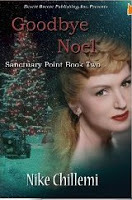 Goodbye Noel
"Wow! Nike Chillemi knows how to set the hook into readers right from the first page and refuses to let go. ~ Robert Liparulo, Award winning author of The 13th Tribe, Comes a Horseman, Germ, and The Dreamhouse Kings
Goodbye Noel
"Wow! Nike Chillemi knows how to set the hook into readers right from the first page and refuses to let go. ~ Robert Liparulo, Award winning author of The 13th Tribe, Comes a Horseman, Germ, and The Dreamhouse Kings
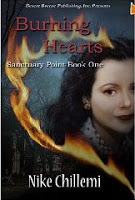 Burning Hearts
"Right from the start, Burning Hearts captured my imagination and tweaked my curiosity. Nike Chillemi certainly knows how to set a scene and ignite excitement." ~ Athol Dickson, three time Christy Award winning author of Lost Mission and The Opposite of ArtHow about you? What's your favorite aspect of the 1940s?[image error]
Burning Hearts
"Right from the start, Burning Hearts captured my imagination and tweaked my curiosity. Nike Chillemi certainly knows how to set a scene and ignite excitement." ~ Athol Dickson, three time Christy Award winning author of Lost Mission and The Opposite of ArtHow about you? What's your favorite aspect of the 1940s?[image error]
Published on September 20, 2012 04:00
Today in World War II History
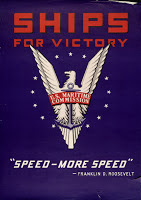 70 Years Ago—Sept. 20, 1942: As of this date, US production of Liberty ships exceed sinkings.[image error]
70 Years Ago—Sept. 20, 1942: As of this date, US production of Liberty ships exceed sinkings.[image error]
Published on September 20, 2012 03:00
September 19, 2012
Today in World War II History
70 Years Ago—Sept. 19, 1942: New song in Top Ten: “Wonder When My Baby’s Coming Home?”
Published on September 19, 2012 03:00
September 18, 2012
Today in World War II History
70 Years Ago—Sept. 18, 1942: On Guadalcanal, Marine reinforcements arrive, also supples, fuel, vehicles, and ammunition, allowing restoration of full rations.
Published on September 18, 2012 03:00



